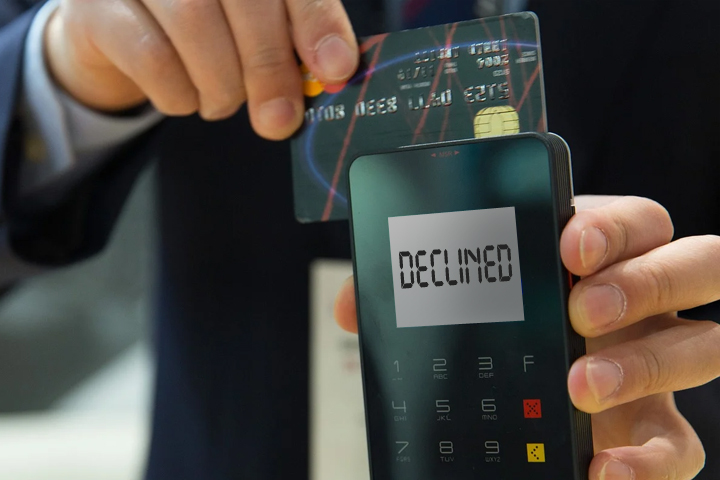Payment declines: how to fight back

More than a minor annoyance, payment declines are enough to halt a significant number of your online sales in their tracks. What can merchants do to protect themselves from the effects of these errors and safeguard their revenues, particularly when it comes to subscriptions?
Whether out of frustration or embarrassment on the customer’s part, subscription and e-commerce companies could be losing 2-5% of all their business to so-called card declines – the rejection of a card payment that can happen for a number of different reasons.
In the US, some 40 million consumers experienced an instance of card decline in 2018-19. The explanations can be varied – from the cardholder having maxed out their account funds or credit limit, to payment details changing, or a new card having been issued.
In the case of a soft decline, the bank has approved the payment, but the transaction fails due to other issues, such as a spending limit being reached, or the card being used abroad. These payments can sometimes be approved later, even with the same information that was already entered.
With a hard decline, however, the payment is foiled by the customer’s issuing bank, requiring the entered card information to be updated or replaced before the transaction can be made. This can be due to a card having been reported as lost or stolen, or the linked account being closed.
Sometimes though, legitimate transactions can be incorrectly flagged and blocked due to a false decline, which are estimated to have cost sellers in the US, UK, Germany and France $20.3 billion in revenues in 2019, with customers either choosing another merchant as a result or abandoning their purchase altogether.
These losses could tally up to a whopping $433 billion in 2021 – 70 times greater than losses due to actual card fraud. And higher purchase amounts tend to trigger payment declines more often, meaning that sellers stand to lose more from false declines in these instances.
Other than in obvious cases, exactly what can trigger fraud detection systems is not always clear; banks are cagey about revealing what factors their algorithms looks for, to not tip off fraudsters as to how to game their systems.
Merchants must juggle the signs of “fraud” with the nature of online purchases: the customer doesn’t need to be present when the transaction takes place; a physical card doesn’t have to be used; and the buyer and seller being located potentially quite some distance apart.
Frustratingly, in many instances, there’s little that sellers can do themselves about problems such as insufficient funds or incorrectly entered details, other than having measures in place to clearly explain what went wrong to customers before they attempt to make the purchase again.
But with 42% of customers abandoning their purchase with a retailer if their card was declined, sellers must nonetheless strive to optimise their payment processes.
The most common reasons for payment declines include insufficient funds, responsible for over 40% of all online transaction declines, and simple payment errors, where the payment information entered does not match the details of the registered cardholder.
But when it comes to subscriptions, it’s rare that customers pay close attention to their recurring payments, so service providers must take proactive steps to minimise the friction caused by card declines to avoid losing out on regular payments.
For example, customers may have to confirm personal information or verify their identity with multifactor authentication - entering a code received via a mobile device to authorise a transaction. By providing as much personal information as possible (and appropriate) in transaction requests, the bank can verify payments with greater ease without falsely triggering its fraud detection algorithms.
Merchants can also employ CVV confirmation, Verified By Visa or 3D Secure, taking contextual data into account to authenticate certain payments and prevent fraudulent transactions from occurring. If the information entered doesn’t match with what’s on record, then the transaction will fail.
Moreover, 3D Secure mechanisms (3DS1 and 3DS2) require at least two out of three authenticators from customers: something they are (their biometric data), something they have (their 2FA-enabling device) and something they know (their password) to confirm they are the legitimate card holder.
Other strategies to increase the efficiency of your payment processing and reduce card decline rates include:
- Pre-empting the issue with a communications strategy targeting customers whose payment details are nearing expiration with instructions on how they can update them – part of a broader marketing campaign reminding customers of the features they stand to lose.
- Using a Recurring Indicator to clear payments that follow a recognised pattern, or to identify regular subscription payments that the customer has signed up to.
- Having a payment retry process in place to automatically follow-up on any failed transactions and collect the money owed.
- Employing updater programs, such as MasterCard Automatic Billing Updater and Visa Account Updater, which automatically update payment details for expired or reissued cards each month.
- Offering alternative payment methods, such as ACH, bank transfer, Direct Debit, PayPal or a digital wallet app.
Just because your billing processes are automated doesn’t mean that managing them can take the backseat. Recurring payments come with their own challenges that must be overcome at every stage of the payments lifecycle for your business to thrive.
For every decline that saves your business from fraudulent payments, you could be losing many more legitimate purchases and vital revenue. By utilising as many methods as possible to reduce your payment decline rate for legitimate transactions, you’ll preserve your income while avoiding customer churn.
Contact us now to find out how Cerillion Skyline can help streamline your subscription business and minimise payment declines.

